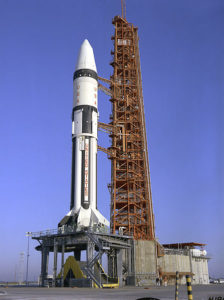On January 22nd, 1968 a Saturn 1B rocket launched from Cape Canaveral Air Force Station Launch Complex 37B carrying the first Apollo Lunar Module into orbit for its first in-space test flight.
While Apollo 4 had tested the massive Saturn V, itself, of course, a critical machine in physically getting to the Moon, Apollo 5 was a much more humble event in that it was simply to test the Lunar Module in Earth orbit – nothing more. The Saturn 1B was only powerful enough to launch either an Apollo Command / Service Module which was partially fueled into Orbit, or a fully fueled Lunar Module – it couldn’t do both. As such, just like Apollo 4, this mission would launch without a crew, and thus be automated from the ground.
The Saturn 1B that launched this mission was itself a machine of note, identified as “SA-204.” This vehicle was the Saturn 1B originally to carry the ill-fated Apollo 1 mission into orbit. Just shy of a year after the fire, it would finally fly carrying not an Apollo CSM, but the LM to successful testing.

The SA-204 Booster, originally planned for Apollo 1, was used for the Lunar Module test mission Apollo 5
Apollo 5’s test plans were simple – test the Descent Propulsion System, the throttle-able rocket engine which would work to land the vehicle on the Lunar surface, and following completion of those tests, fire the Ascent Propulsion System in a scenario much like that which would be needed int he event of an abort of a Lunar landing attempt. As this flight would not have a crew on board, nor would it be landing on the Moon, it lacked windows and did not carry landing legs.

The launch was without issue, but there was a concern of a possible leak in the Descent Propulsion System – the engine arming was delayed until just before the planned time of firing, but this safety measure created another issue in that pressure in the fuel tanks wasn’t built up properly as it would have had the system been armed before launch. The Apollo Guidance Computer wasn’t updated to expect lower (but still safe) pressure levels and shut down the engine 4 seconds into its first firing. Flight controllers however still forced the engine to fire successfully 2 more times before moving on to the “fire in the hole” test, where the Ascent stage engine would be fired while still attached to the Descent stage – as would be the case in an abort, or (in a much stable state) when launching from the surface of the Moon after landing. This engine fired successfully, and was later fired another time successfully before the mission was concluded just over 11 hours after launch.

The spent stages were left to burn up in the Earths atmosphere, the mission having been deemed a success.
For now, all I have to leave you with is this film on the flight, from 1968. It covers it pretty well and includes the launch of Apollo 5, something I’ve actually not been able to find any good footage of – isn’t that usually the point of these articles, to show off the launch of the missions anyway? Hah!
Enjoy!
